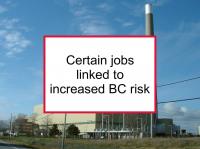Some occupations appear to increase breast cancer risk. Breast cancer survivors and those at high risk may be better off avoiding these occupations or limiting their exposure to associated risk factors. Those at high risk for breast cancer include daughters of women with breast cancer and both sons and daughters of BRCA mutation carriers.
The most common occupational risk factors are exposure to carcinogens and endocrine disruptors, however night shift work has also been implicated. Now a new Canadian study has identified some occupational sectors associated with heightened risk of breast cancer.
Occupations and exposures associated with increased BC risk
Certain occupations and long-term exposures have been found to be associated with increased risk of breast cancer:
- Women exposed to ionizing radiation on the job have increased breast cancer risk. Examples include airline cabin crews, radiologic technologists, and orthopedic surgeons. On the other hand, exposure to magnetic fields does not appear to increase breast cancer risk.
- Nurses and other women engaging night shift work over the long term have increased risk of breast cancer, according to most studies that have investigated the association. The most disruptive shifts (graveyard shifts, rotating night and day shifts) appear to contribute the greatest risk.
- Working in or very near to steel and pulp mills, petroleum refineries (and jobs involving exposure to polycyclic aromatic hydrocarbons (PAHs) from petroleum sources), thermal power plants, textile plants, and rubber and plastics manufacturing plants can increase breast cancer risk.
- Textile workers and tailors/dressmakers (especially those working with acrylic, nylon or rayon fibers) have been found to have increased breast cancer risk, as have metal workers (such as automobile workers) exposed to metalworking fluids.
- Working in some small businesses such as dry cleaners using tetrachloroethylene and auto repair shops also can increase breast cancer risk.
- High temperature work environments have also been implicated in the development of male breast cancer.
The impact of pesticides is less clear — most low-level exposures do not appear to increase breast cancer risk. However, there is some evidence that concentrated exposures could increase it. It makes sense to avoid pesticides that are applied in enclosed spaces such as greenhouses and mushroom farms.
Latest research finds link between certain occupations and BC
The case-control study referenced at the beginning of this news article was designed to investigate possible links between breast cancer and occupation, with special emphasis on farming and manufacturing jobs. Potentially harmful exposures to carcinogens (some known and others not yet classified as such) and endocrine disruptors (chemicals that interfere with hormone systems in the body) are common in a variety of occupational settings. The study included 1,006 women with breast cancer and 1,146 cancer-free controls. Jobs were categorized by industry and occupation and cumulative exposures to carcinogens and endocrine disruptors were estimated.
Women with potentially high exposures to carcinogens and endocrine disruptors were found to have elevated risk of breast cancer (1.42 times the risk of low-exposure women for exposure duration of 10 years) across all occupational sectors. Specific sectors associated with elevated risk included automotive plastics manufacturing (2.68 times), food canning (2.35), bars and/or gambling (2.28), metalworking (1.73), and agriculture (1.36). Premenopausal breast cancer risk was found to be highest for workers in food canning (5.70) and automotive plastics (4.76). The estrogen receptor status of tumors appeared to be influenced by occupation. The authors conclude that the study results indicate a possible link between breast cancer risk and occupations likely to involve exposures to carcinogens or endocrine disruptors.
Please see our articles on occupations that are associated with increased risk of breast cancer and how to protect our daughters from breast cancer for more information.
